Artificial food dyes are unfortunately in quite a lot of processed foods. I've already shared all the reasons I hate them, but today I want to share the names of the FDA-approved dyes so you can look for (and hopefully avoid) them in food products.

Want to Save this Recipe?
Enter your email below & we'll send it straight to your inbox. Plus you'll get great new recipes from us every week!
Note: This is the "currently approved" list because, unsettling enough, the approval status does change.
The following FD&C color additives are either no longer authorized or restricted for use - that’s right the FDA once thought these seven food dyes were “safe” but have since changed their minds: Green 1, Green 2, Red 1, Red 2, Red 3 (still used in food, but no longer in cosmetics or external drugs), Red 4, and Violet 1. In fact, if you look at food, drugs and cosmetics in total there are 91 different dyes that were once approved and are now no longer authorized or restricted for use.
In the UK artificial dyes are allowed for use, but require a warning label stating, “May have an adverse effect on activity and attention in children." So, as a result, food companies have mostly switched to natural dyes in order to avoid slapping a warning label on their packages.
Even though these dyes are still widely used in the US, I did find this statement on the FDA website, "Exposure to food and food components, including AFC [artificial food colors] and preservatives, may be associated with behavioral changes, not necessarily related to hyperactivity, in certain susceptible children with ADHD and other problem behaviors, and possibly in susceptible children from the general population."
I'd also like to share a link to a really interesting science experiment conducted by a kid who tested the effects of yellow dye in mice. The results are rather astounding...click to see for yourself!
Artificial Dyes Found in Surprising Places
What was once reserved for colorful, celebratory cake frosting is now lurking on almost every shelf in the grocery store. In fact, consumption of food dyes has increased 5-fold since 1955 (up from 3 million to 15 million pounds per year) - 90% of which is from Yellow 5, Yellow 6, and Red 40. This is one of the many reasons why the argument that we grew up eating this stuff and turned out "just fine" doesn't hold up - processed food has changed (and continues to change) since we were kids.
So nowadays unless you shop somewhere like Whole Foods or Earth Fare (supermarkets that don't allow products with artificial dyes), get ready to do some label reading in order to avoid the above list on your next shopping trip.
Below are some examples where we found artificial food dyes. They are not just found in neon colored beverages and brightly colored candies - all of the following (even including brown cereal, whole-wheat pizza crust, and white icing!) are examples of packaged products that contain artificial dyes:
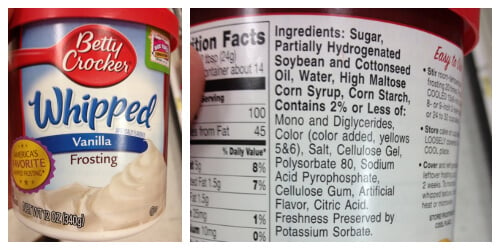
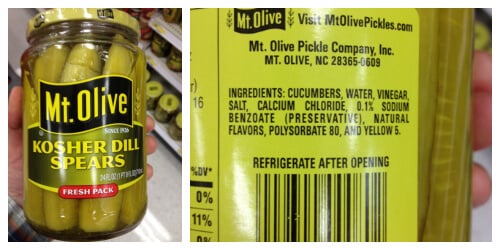

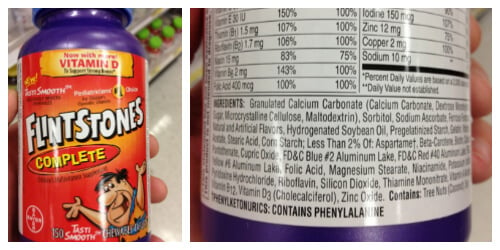
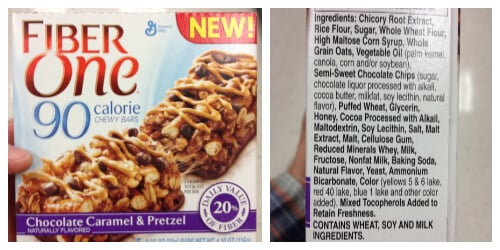
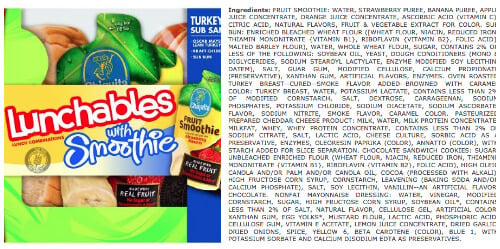
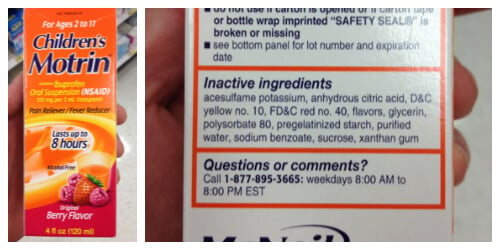
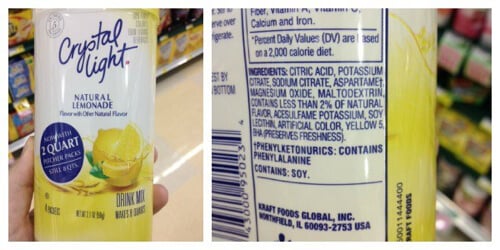
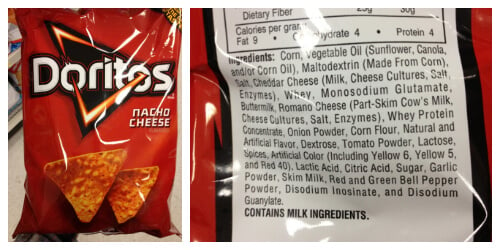
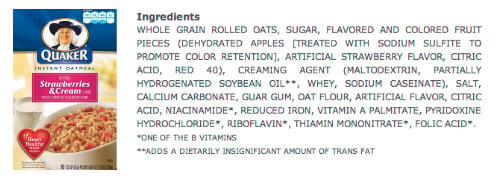

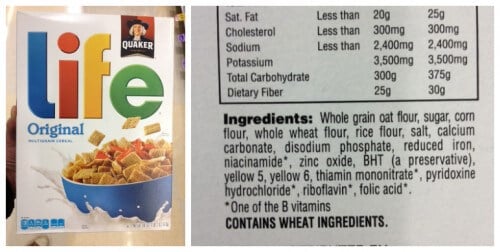
Have you found artificial dyes lurking in surprising places? Please let us know in the comments below.





Mallory says
Does anyone know of any pickles that don't have food dye in them? I know cucumbers are green, honestly, why do they have to stick the yellow in there?...
Nicole says
I don't know if you are near a Publix but they sell a dye free pickle in the cooler section. The brand escapes me right now.
Lisa says
Hey,
I'm allergic to the yellow #5 commonly found in shelf stable pickles. I buy "Classen's" from the refrigerated case. They're crunchy , delicious & come in many varieties.
Enjoy ,
Lisa
Marisa @ Ware It's Made From Scratch says
Yes! Trader Joe's has non-dye pickles, but if you aren't near one, there is a brand called Bubbies. http://amzn.to/11T5083
Tracy says
They are easy to make to keep in the fridge: Put a layer of dill, and garlic, add cucs, pickling cucs are preferable. Add more dill and garlic and more cucs. Mix 1 gallon water and 1 cup white vinegar 2/3 cup pickling salt, 2 tbl pickling spice, mix til dissolved. Pour over cucs, let sit on counter for 2 days with lid slightyly off, then refrigerate. They are ready to eat, but taste better the longer they sit.
Aola says
Has Yoplait changed their ingredients or is it just the light yogurt that has dyes in it? The original uses food based dyes such as annato
Assistant to 100 Days (Amy) says
Hello Aola. Their products could vary ingredient-wise. I'm not sure what they have done in the past. ~Amy
Stacey says
Thank you so much for the information. I have been working towards a "real food" diet for my family. We're not perfect, but it's a lot better than what we were eating before. We took a 9-day family vacation and returned a couple of days ago. My 4-yr-old son has been having major behavior problems since eating all of the "junk" that we had on vacation. I think it is linked to the food dyes. I'm doing research this morning before I go to buy groceries today!
Leo Regulus says
Back to nature is the best way. Humaniy was once vegetarian natural, until we were misled into devouring animals and chemically induced foods for the profit of big business. Learn again to grow your own food. The human body can survive without the slaughtering of animals. You will never have felt better or lighter.
Sam says
I took my kids off of artificial colors about 18 months ago and it has been an uphill battle ever since. I try to explain to people that I don't allow my children to have artificial colors and people don't understand. They are so perplexed as to what that means. Then they are flabbergasted by everything I don't allow my children to eat. And artificial colors are so pervasive in our food at school, parties, candy that people hand out at the bank and store, holidays, etc. I always come across as the bad guy. I finally had to compromise and let my oldest eat articial colors at parties. Since it's not an official allergy people do not feel obliged to follow my requests. I have noticed that my oldest is sensitive and it has helped her behavior to get rid of the food that has not artificial colors.
Alyssa B says
I poured my artificial dyes down the drain yesterday in favor of something natural. There are so many options out there for doing it naturally!
This is an example of a rainbow cake flavored and dyed with fruit: http://iambaker.net/mothers-day-garden-party/
And here is a great post about making your own food dyes: http://bonzaiaphrodite.com/2013/03/natural-homemade-food-coloring-for-baking-frosting-and-easter/
Hope this helps!
Tina says
Thank you so much for all of your research and information. I recently discovered the ill effects of dye's in food when it came to my daughter. She began her kindergarten year on a good note, but about a week into school she started to have violent temper tantrums at school, throwing desks, and arms and legs flailing everywhere. A friend of mine had told me about Red #40 and aggression so I started to look for it in her foods. I would have never imagined that Flintstone vitamins would contain an ingredient that would cause such horrible behavior and I was giving it to her daily for about 2 months. Can you imagine the daily phone calls and the shame you feel with a new school that you have the "problem" child? I stopped giving them to her and my sweet angel is back. I watch EVERYTHING now. Thanks again.
Melissa D says
My ordinarily well-behaved kids spent the day after Easter fighting and *head-butting* each other! I had allowed them to have one "Reester Egg" in their baskets.
We've cut out all food dyes and additives at home pretty painlessly since I love to cook, but holidays and school celebrations make it hard. I hate to be "that mom" telling other moms what to bring, but my kids know just to bring everything home to be vetted. We don't make a huge deal out of it, just throw out the candy and junk and keep the erasers and empty plastic eggs. My kids get huge, red itchy hives after eating food dyes, so that helps them understand that the dyes really are bad for them.
Kim says
Overheard my 7 yr old telling her younger sister (age 4) that "junk food" is anything with artificial colors or lots of sugar made me realize that this transition to real foods, which truly does take time is ABSOLUTELY worth it!
kavi says
how can we identify the food dyes in food?can we use chromatography experiment to identify the food dyes in such food like jelly,desserts,marshmellows and etc.
Assistant to 100 Days (Amy) says
Hi Kavi. I am not familiar with using chromatography in that way. Food colorings should be listed on the ingredient label. ~Amy
Tracy says
So I checked my cheese, both Cracker Barrel and Kraft Cheddar cheese are colored with annatto (which I had to look up) It looks like it is natural but says there can be food allergies. Is this food coloring safe?
Assistant to 100 Days (Amy) says
H Tracy. Annatto is known to cause some fairly serious reactions in sensitive individuals. I would say that the jury is still out on its safety. ~Amy
Dye Diet says
Crystal Light is NOT a surprise at all. MUCH MORE surprising is to find dozens of mg of artificial colors (azo dyes) in SEEMINGLY sane dried FRUITS: Trail Mix es and dried papaya and dried mango: http://www.dyediet.com/2011/06/19/candy-and-snacks/dried-fruits-food-dyes-added/
http://www.dyediet.com/2011/06/15/food-dyes-exposure/dyed-dried-papaya/
Take care!
Mick says
I just mixed some herbalife wild berry flavour healthy meal nutritional shake mix with milk and noticed a run of what looked like blue dye. A quick inspection of the package reveals red 40 lake in the ingredients. "If it's Red 40 LAKE it's even more dangerous because the consistency is changed and it "sticks" in the liver longer, producing longer-lasting results. Results include anywhere from extreme hyperactivity to psychotic behavior and extreme mood swings." The shake package mentions artificial flavouring on the front but nothing of colour.
Herbalife claims their mission to be
"To change people’s lives by providing the best nutrition and weight management products and the best business opportunity in direct selling in the world." on their facebook page. Hmmm, wanna by some petrochemical tainted health products from me?
Kelly says
I am both shocked and disappointed about this post. I almost don't want to believe it because these are things my kids and family love. I've been eating LIFE for breakfast for years and it makes me sick to think they have artificial dyes in something that needs no color! I must say, thanks to your post and a bit more research, I had no regrets tossing it in the trash along with gatorade and fruit snacks. So I want to take the time to thank you for bringing this to our attention and can only hope that by eliminating these foods, and a majority of the other cancerous causing foods, we can start fresh...well, by buying fresh. It's a lifestyle change and it won't be an easy feat but I am determined to give my kids the life they deserve and the life I deserve watching them grow old :)
Kelsey D. says
To Lisa & Vani: Can either of you direct me to a petition on change.org or help me start one that's directed to the FDA from the consumers in the US to ban artificial dyes, colors and preservatives as well as GMO's from our food? I'm actually surprised I haven't been able to find one. Is there a reason I'm missing that food activists haven't done this yet? This is the best way to spread the word to consumers that are unaware of the issues. By sharing the link to petition it, I think we can reach the majority of the people and get them to take a stand for their health. I think it would also be good to put a list of all the additives that are banned in other countries asking the FDA why we're an exception for these health standards. Please let me know. I so badly want to take action with this! I'm just so fed up with it.
Jackie R says
I found that my Neutrogena facewash has Yellow 5! I switched to the 'Neutrogena Naturals' line instead ... why can't they just make all their facewash natural?
Stephan says
I just prepared a bubble bath for my kiddo and as i was adding the bubble mix i looked at the ingredients. Dora bubble bath has Red 40. Adding color just so that when you pour it out its not just clear. Crazy! Once the liquid mixes with the water and forms bubbles the color is gone, why add the dye!
Shabaritha says
Thanks for this post.
My son is allergic to soy and artificial food coloring so there is practically nothing that I can buy for him from a regular grocery store or a restaurant. As long as he is home, he is fine but he always comes home sad and crying when he looks at other kids eating all these colorful looking prepackaged junk food loaded with artificial stuff. Every week there is some or the other kid having a birthday party or other parties like valentines or Halloween and they are served colorful cupcakes and snacks....none of which he can have. Our social life has also come to a stand still as most of the gatherings is around food and we don't want him staring and crying while other kids are enjoying. I wish it was easier. I wonder if we will ever take him to a theme park where every other store is a food stall.
Thanks to food blogs like yours, people are becoming aware of the poison that goes in processed food.
Thanks again for all the info and all the comments by other moms sharing their experiences.
Markey says
Shabaritha - Are you aware of the support group called the Feingold Association http://www.feingold.org ? It's a great org that helps families find foods in regular supermarkets, restaurants, etc. that don't have artificial colorings, etc.
I hope all the publicity that the Kraft issue has created will lead to more products without dyes. The Feingold org (created by parents) has been helping parents since my kids were babies and has the same goal as these 2 great moms.
Jennifer says
My son got to the point where he didn't want to have wetting accidents anymore. Food coloring does that to him.
We found a way around the cupcake issue by asking the teacher to keep a sandwich bag of chocolate for him as an exchange for a cupcake. She agreed and now he makes those trades. We aren't much on candy at our house, so this is a pretty special treat too.
At parties we take a homemade frosted cookies which I store in the freezer- again something he loves.- so he doesn't miss out on a treat.
For baseball, they serve a snack at the end, he can't have most of them, so I buy the single serve Pringles (while not ideal, they are a huge treat for him) and sometimes the other kids want what he's having!
Jennifer says
Ha ha! He gets two pieces of candy for a cupcake trade, not a whole bag!
Jennifer says
Thank you Lisa and vani for all that you have done to try to fix the artificial dye issue with Kraft. I have written about it on my blog, http://www.ourholisticjourney.com, to share the info.! Thanks again!
Emily says
Children's toothpaste! Many items that tout "natural flavoring" especially "fruit snacks", goldfish crackers (though the rainbow version have natural colors!) and juices. Baby finger foods, like yogurt bites by some brands. My daughter has an adverse reaction to red 40, it is amazing what a difference it has made for her to cut it out 100%. I am finding more and more foods that don't have artificial dyes than I did a year ago when we started eliminating. Yellow is next to go, but that will probably come when I can get to the final push of eliminating all processed foods, but a a full time working single mom it is a challenge to go 100% "real" so I'm just trucking along doing the best I can.
Tiffani says
Pillsbury Croissant Rolls - red 40. Food Lion or Kroger brand croissants have yellow 5 & 6. The only place I can find ones safe to use for my kids is at Trader Joes, which is 45 minutes away. :( And my son's favorite meal is pigs in a blanket (and I've never managed a good homemade replacement).
Joy says
Tiffani, have you tried Laura's yogurt dough (from http://www.heavenlyhomemakers.com)? We use it all the time as a healthy replacement pastry dough. Makes great homemade "Pop Tarts", too! Here is the link: http://heavenlyhomemakers.com/my-favorite-versatile-whole-wheat-dough -Joy
Jenny says
Cheese...until recently I thought it was natural that cheddar cheese was suppose to be orange! It's scary where dyes and chemicals are added.
Nicole says
To avoid artificial food dyes, choose organic products.
http://www.organicnewsroom.com/2010/07/consumers_can_choose_organic_p.html
Theresa says
Thanks for sharing this info and raising awareness; so many people assume dyes are benign in food (and other products) labels.
Michele says
Children's form of liquid Amoxicillin also has RED Dye #40 in it. This is how we found out that my son has a reaction to all RED Dye #40! We now do not have anything in our house with RED Dye #40. It is unbelievably scary how many food products have it.
Mara says
Artificial ingredients (dyes, flavorings, preservatives, etc.) across the board are just bad news. We avoid anything artificial for our sons due to my youngest aspirin allergy and salicylate sensitivity. We have to be careful with certain plastics and other materials due to the salicylate sensitivity. This includes water toys, seat belts, the elastic in any clothing, etc. He develops body hives, facial swelling and throat swelling when his body reaches it's limits of salicylates (they can remain in your system for up to 48 hours). Anything including toothpastes (my boys use a line of Tom's that's safe for him to use and for my older son who has a gluten sensitivity), shampoos/body washes (they use Shea Moisture, it's been around since 1912) and for my oldest I just picked up some deoderant, to have on hand for when he does need it (a Kiss My Face that's gluten free), though my husband thinks it's going to be a while because they eat so clean.
My son will have a reaction if someone kisses his cheek with lipstick on. Dyes and my son do not mix.
The great thing is, you can make just about any food you want from scratch. It's just that time investment that not everyone has.
Rachel says
I was giving my daughter a bath and put in the Elmo dissolving bath fizzes. They turn bath water colors. I have been focusing so much on artificial coloring in foods, I never thought to look into other items, but they did contain red, blue, and yellow artificial colors!? That is getting absorbed into our children's skin, the largest organ, and going right into the bloodstream. Infuriating!!!!
Cathy says
That's not really true. The skin's job is to protect us by being a BARRIER. Some things circumvent that, but it depends on solubility, concentration, duration and other factors. A child in a bath with colored fizz (low concentration, notice they don't stain the tub) probably absorb less than a child coloring with a marker, which likely still isn't anything detectable. The pharmacology industry has had to work hard to get patches to work to deliver meds and that's high concentration and duration.
Ludicrous Mama (@BitingMyHand) says
I'd be more concerned about lip balms and chapsticks, toothpastes and mouthwash. Unless she has a skin reaction, or drinks the water, she should be fine.
Christi says
I've been cracking down on artificial colors after finally realizing just how sensitive my 10 y.o. Is. We mostly cook from scratch, but there are still outside sources of foods and candies. My first clue with her was when her skin got terribly rashly after switching shampoo. What sealed the deal is when she went to a "jell-o bowl" activity. After she put her hands in a bowl of jell-o they immediately had a bad case of eczema covering both hands to her wrists. I was appalled before at what goes into our food and health products, but this has driven it home. Thank you for a very relevant article!
Margaret says
Just this morning I found "India Tree Nature's Colors Decorating Set Created with Vegetable Colorants Red, Yellow, Blue" at Great Harvest Bread. I couldn't get a good picture of the package, so here are the ingredients
Blue: Glycerin, vegetable juice, deionized water.
Red: Beet juice, citric acid
Yellow: Glycerin, turmeric, deionized water.
Couldn't believe my eyes when I spotted these...so exciting!
jane says
We've been using India Tree colors for about 6 months. The red is a little dull, but my 6 yr old is so happy we can decorate and eat cupcakes with colors now! Keep the dyes in the fridge for longer life. :)
Ludicrous Mama (@BitingMyHand) says
Beets. It's concentrated from beets. You can chop, boil, and puree up a beet and sub out 1:1 for oil (and save the water to add to the mix too! Or freeze in an ice cube tray and save for smoothies) for a very vibrant burgundy.
Ludicrous Mama says
Marshmallows (the colored ones, obviously, but the white ones have fake Blue.)
Non-fat cream cheese.
Almost all Pillsbury dough products
Shelf-stable and frozen juices (especially the blended flavors)
Frozen "Blue"berry waffles
Pretty much every medication. Either the pill is colored, or there is an identifier printed on in fake colors. (Benadryl, Mylicon, Tylenol, Advil, Zyrtec and a few others make dye-free children's liquids, but they all have fake flavors, which can also contain petrol-derived ingredients. Only there's no way to know for sure!)
Cathy says
Medications are almost completely synthetic. I have no problem with a few more synthetics to make it go more "appealing" and more likely to go down. Teach your kids to take pills, or ask for pills and crush them (or open them). Many older antibiotics and OTC pain pills are OK to crush. I know 2 people who were given natural liquid med as children-once each. One took years to learn to tolerate honey because that's what their's was sweetened with, the other still won't eat anything with mollassas (the sweetener for hers), so in my book, if you must, bring on the artificials! Cathy
Ludicrous Mama (@BitingMyHand) says
The problem is that if the colors and flavors in the medicine for her infection causes her to have night terrors, uncontrolled screaming fits during the day (where she is unable to communicate or do the most basic things, until it's blown over,) and prevents her from being able to fall asleep at night, it's not really a good "cure."
Pills are not necessarily dye-free either. Many all-white pills are made brighter with the addition of Blue dyes. For her allergy medication, the children's liquid has artificial flavor, which could be petrol-derived, and the pills have Blue. I have to pay 5 times more for the brand-name, which happens to not have artificial colors, but that is not the case with all medicines.
Cathy says
That's true but generally pills have less dyes. They are colored and shaped to improve safety and made large enough to manage. Have you ever tried to help an older person organize all their pills? Thank goodness they have some differences. One thing to talk with your Dr and pharmacist about is using meds in their IV solution form. More pure then, but nasty. Of course again most meds are synthetic so if your child reacts to most synthetics then they might react to most meds as well.
Ludicrous Mama (@BitingMyHand) says
The reason kids are reacting to these ingredients is that they're petrol-derived. All the artificial food dyes, some flavors (impossible to know which, since they're all labeled "flavor added" or "artificial flavors,") and the preservatives BHA, BHA, and TBHQ. Not all kids react to all the dyes and/or other petrol ingredients. But to many that do, even the tiny amount of color on the markings can trigger a reaction. It's not a quantitative reaction in most kids. It's more of a pass/fail. The severity of the reaction may vary though. But I don't feel safe feeding my child something that negatively affects her BRAIN.
This isn't like lactose intolerance, where we can choose to have a gassy and tummy-crampy night to have ice cream. This causes behavioral changes that often result in the child losing control of their own behavior. My daughter used to have random screaming fits, where all she could do was sit there screaming "NO!" over and over. If there were objects near her, she would throw them, and if you touched her she would become a whirling dervish of fists and feet. She couldn't respond cognitively to questions. ("Do you want me to stay?" NO! "Would you like me to go away?" NO! etc.) She was unable to perform basic tasks during these fits and her night terrors/night wakings. She literally COULD NOT get up out of bed and walk to us if she woke up. She couldn't even grasp her sippy cup of water by the side of the bed. But I had to sit through 10-15 minutes of screaming to get to where she could even tell me that's what she wanted.
And the most painful part for me is that she KNOWS she's not in control. One time, she was able to pick up a little door hanger she had made at school, where one side said something like "stay out" and the other said "come in and play." She looked at both sides and handed it to me with the "come in and play" side up, but couldn't stop screaming "NO!" She wanted me to know she needed me, but couldn't tell me. I will never intentionally risk her feeling like that ever again, unless it were a life-and-death situation.
This little girl, at 4 years old, decided that she didn't like that feeling, and is voluntarily complying with our artificial-free diet. She won't eat anything out of my presence without asking if it has "no fake colors and no fake flavors." And she often just refuses their snack in favor of the one I packed for her, even if the teacher says it IS safe. She gladly traded in all her Halloween booty. She was even worried that the Easter Bunny and Santa would bring her stuff that wasn't safe, and made me check each item first. We throw out most of her Valentine's Day booty, birthday party favors, and bring our own substitute for birthday cake, which she happily accepts.
I will not undermine her efforts at her own health and well-being because the FDA has their heads stuck up their butts and refuse to see what more and more other countries are seeing, and restrict the use of food dyes.
Cathy says
But many, many medications (there are vague lists on line-you'd have to check with a PharmD for specifics) including antihistamines are derived from petroleum. So saying petroleum derived medication can't have petroleum derived additives doesn't make sense. Usually even with true allergies (even anaphylaxis but that's done under an allergist care) frequent exposure to small amounts of the allergan is good. There's usually a threshold where the person won't react.
Yasmin says
Could someone please explain to me why Benadryl (diphenhydramine) contains unnecessary food dyes? I find it absolutely shocking that something which might cause an allergic reaction in some is in allergy medicine!
lorraine says
I am an older woman, and have been in the hospital 14 times, with a swollen tongue. Had to be treated and no fun. The latest is an allergy of red dye 40. But is is called other names also, like annato and some others. Thanks for all your work. I cannot understand why the U.S. does not do anything. I also wrote to Pillsbury, and also the President and Mrs. Obama. I read everything and I missed at least 14 times. I have be careful.
Kepp up the good work.
Ludicrous Mama says
Anatto is actually a natural plant-derived colorant, found in almost all orange cheddar products. Some people still react, but some people react to gluten too. Doesn't make it a petrol-derived ingredient.
Cathy says
That doesn't change the fact that it's a dye that is very allerginic, more so than many synthetic. Just because it's natural doesn't make it good. Otherwise go add some opium or pot to your food and call it good.
sarah says
also in the trash can today: Quaker Oatmeal Squares. yellow 5&6.
sarah says
nesquik chocolate syrup... it has caramel color, red 40, blue 1, and yellow 6. chocolate is already brown, why must we color it? i used to buy nesquik bc it was the only brand made with sugar instead of high fructose corn syrup...but i happened to read the label the other day. into the trash can.
Margaret says
We tried Lisa's chocolate syrup recipe and have never looked back! It's delicious and your kids will never know the difference. It's 1 Tbsp of unsweetened cocoa powder and 2 Tbsp of organic pure maple syrup. Takes a little time to dissolve the cocoa powder, but the results are worth it. Hope that is helpful!
Michele says
There is an app for your smart phone (I know it is available on Droid) called Fooducate. You can scan the bar code of a food item and it will tell you if there are dyes and artificial sweeteners, as well as the probability of GMO. Makes it a little quicker than reading those ingredient lists!!
Catherine says
That is very interesting. It sounds like a helpful app. I'm going to check into it but I don't think I'll be skipping reading labels entirely. With all the changes these companies make to slip things by us we have to be vigilant.
Diana @ Eating Made Easy says
This is such an informative post, yet another reason to always read labels. We wrote about a deceiving product from Yoplait for parents to avoid. See the post here: http://eating-made-easy.com/2013/01/29/moms-add-this-to-your-do-not-buy-list/
Beth says
I just wanted to give a big thank you for making such a huge effort in awareness of food safety and healthy eating. I have been following your website for a year, and my family and I truly benefit from it. You are changing the world, one household at a time!
Heather says
I believe they have a dye-free version of Children's Motrin.
Jen says
We use Motrin all the time - I like it better than Tylenol. What would be a good substitute for a pain reliever???
Ulrike says
There is dye-free liquid ibuprofen, in both brand names (like Motrin) and generics. You just have to look for it. Unfortunately, there aren't any dye-free chewables that I've seen.
Tiffany says
A couple of weeks ago, my kids were drinking Langers Apple, Kiwi, Strawberry 100% Juice with "100% Pure Juice" written on the front label, I didn't think it was necessary to read the ingredients as they should all be fruit juice. Right? In bold lettering on the side of the bottle it states "Its 100% Pure". However, after reading the ingredients I found it contained Red 40 which is made from petroleum and Estergum which is used in varnish, laquer, and paint!!!
I wrote to the company and have not received a reply. DO NOT BELIEVE the front of labels. Read the ingredients. Somehow they are allowed to be deceptive in 100% pure claims!
Ludicrous Mama says
Depending on the claim, manufacturers are allowed to have a certain % of non-compliant ingredients. If it contains less than 1% food dye, it can claim to be all-natural or be 100% juice or whatever. (Organics are allowed either 10 or 20% GMO ingredients, due to cross-contamination from nearby farms!)
Jason Leake with 100 Days of Real Food says
Organic is usually GMO free http://gmo-awareness.com/2011/05/05/is-organic-always-gmo-free/
maria @ me in the kitchen says
I try to avoid using artificial food dyes, but the second I let my guard down and don't check, is the very time they slip it past me. Thanks for sharing this information & keep up the great work.
Dana says
One of our boys has emotional reactions to red dye 40. We were shocked when we started looking at ingredients. Pilsbury crescent rolls actually every Pilsbury bread product had red dye 40 in it. Every light/lowfat yogurt had it too. Very eye opening we had no idea had much we were consuming it.